The rise of visibility – Report of the Outsport Webinar 2022
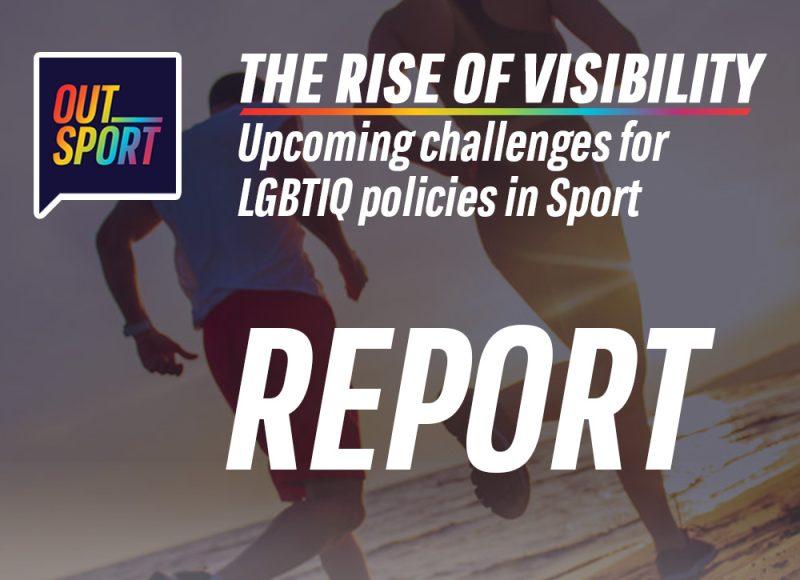
On January 28, 2022, the Outsport Network and AICS LGBTI held the second edition of Outsport Webinar “The Rise of Visibility – Upcoming Challenges for LGBTIQ Policies in Sport” – #WebOutsport2022.
Institutions, NGOs, sports clubs representatives, and experts met to discuss the highlights of 2021 regarding LGBTIQ people and sport.
We titled the webinar “The rise of visibility” starting from the many instances of coming out we had in 2021 and during the Olympics. The general idea of this webinar is how to shift from the fight for visibility to the fight for a really inclusive sport.
In this report we sum up the main outcomes of the webinar.
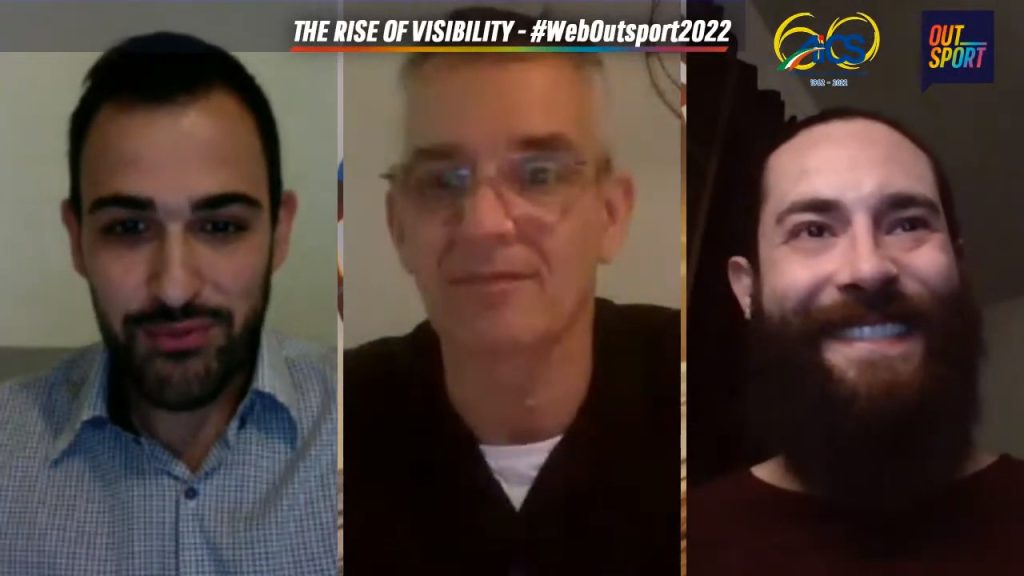
The webinar started with greetings from Rosario Coco, Outsport coordinator, who introduced collaborators Klaus Heusslein and Andrea Giuliano and announced the main topics of the webinar.
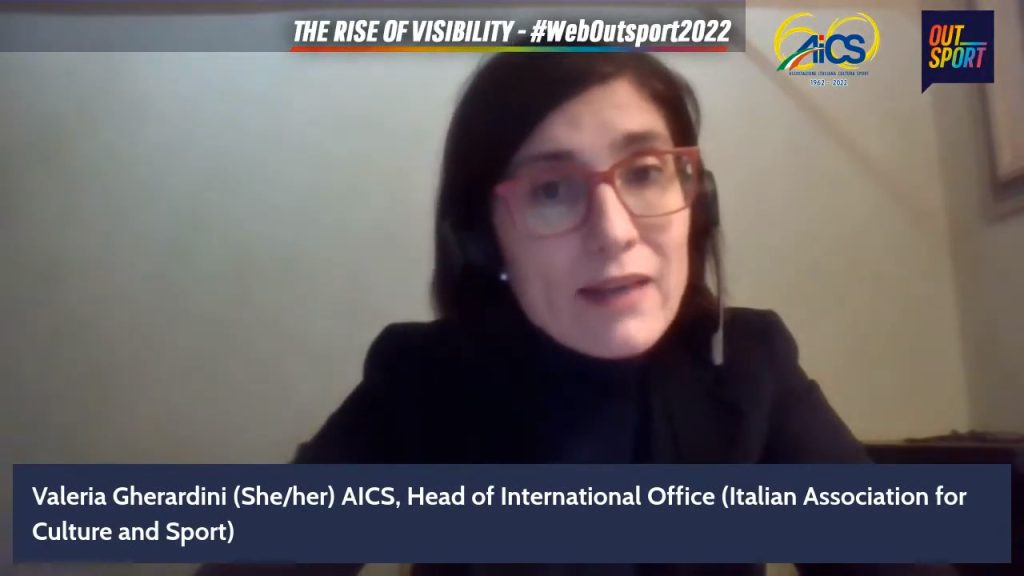
After the opening speech by Rosario Coco, Valeria Gherardini, Head of International Office spoke on behalf of AICS.
AICS, Associazione Italiana Cultura Sport, is a national body of sports promotion. We are based in Italy and we have one million members all over the country. To us, sport is a tool to promote social cohesion in communities and to promote individual and collective health. It is a coherent path for us to have invested a lot also into the LGBTIQ sector, which is why we have established an ad hoc department.
Thanks to the work of Outsport, the EU-co-funded project coordinated by Rosario Coco and with the cooperation of Klaus Heusslein and Andrea Giuliano, we received the results of a European research study led by the University of Sport Cologne that highlighted the needs, and the needs analysis, on how we can create sport practices that are able to be inclusive for all, including all people coming from the LGBTIQ sector. The Outsport project has also produced a toolkit that we use to train our coaches and make them develop their skills in order to promote sport practices that are really inclusive for all.
Outsport has also given us many outputs and deliverables which are also useful at the international level. For example, we participate with the network of CSIT, an international confederation of sports for amateurs and workers. I take this opportunity to announce that next year Rome will host the CSIT World Sport Games, a multisport event open to all. I wish you all a profitable discussion during our webinar.
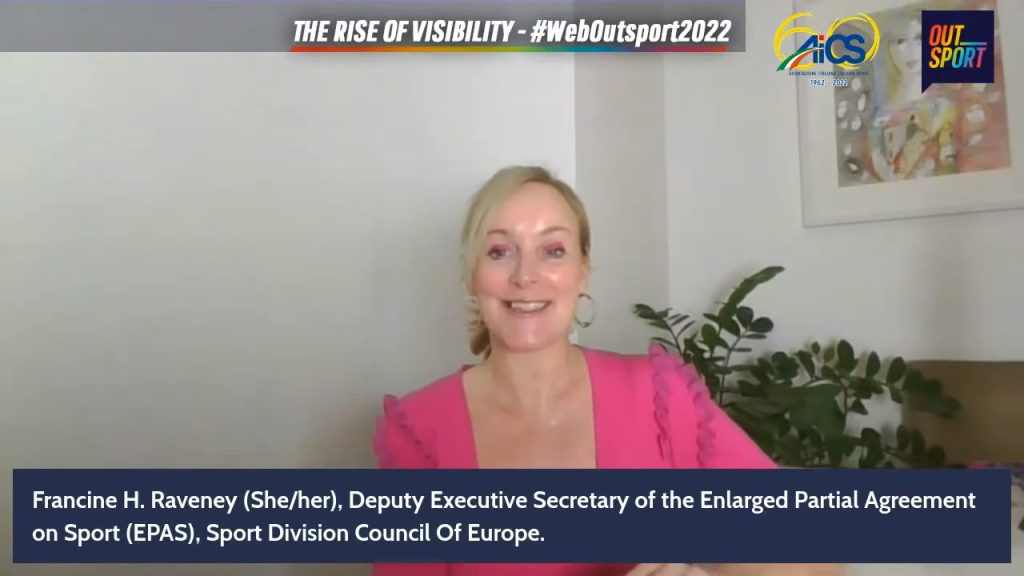
Following the greetings from Valeria Gherardini, Francine H. Raveney, Deputy Executive Secretary of the Enlarged Partial Agreement on Sport (EPAS), the Sport Division of the Council of Europe, presented the work of EPAS.
EPAS is a platform to promote dialogue between policymakers and grassroots sports representatives. Members of the EPAS Governing Body are usually representatives from Departments of Sport at the national level, government representatives that constitute the EPAS Statutory Committee, and grassroots sports representatives, who form part of the Consultative Committee.
We contribute to the drafting of legislation to be adopted by the Council of Europe’s Committee of Ministers. For example, the Recommendation on Gender Mainstreaming in Sport (2015) and the Revised European Sports Charter (2021). This charter states clearly that there should be no discrimination on the grounds of sex, race, colour, language, religion, political or other opinions, national or social origin, association with a national minority, property, birth or any other status shall be permitted in the access to sports facilities or sports activities. It’s a clear commitment to protecting human rights, and that is how we approach this area of our work.
EPAS is part of the Sport Division, a new division that brought together the Committees which work on the sport conventions under one body. This will strengthen the cooperation work that we carry out and it will also strengthen the work that we do in the groundbreaking legal instruments: not only developing, promoting, and implementing them, but also monitoring work. It will allow us to uphold the integrity and the values of sport whilst promoting human rights even more.
One of the main ways that we would like to keep diversity issues always on the agenda is that we host a Diversity Conference every two years. The topics from previous Diversity conferences have included promoting gender equality in sport, which led to a joint, ongoing cooperation project with the EU called All In, fighting racism and violence through sport and combating homophobia in sport – for each of these areas, we also produced handbooks with the information and guidelines.
The subject area has to be approved by the governing board of EPAS at its ministerial meetings, held every other year. I was thrilled to be helping to organize the 2021 conference’s topic on promoting and protecting the human rights of transgender and intersex athletes in sporting competitions. The main aims of this conference are raising awareness, increasing knowledge, sensitising the public, and focusing on the subject absolutely from a human rights perspective. This perspective is cross-cutting all of our resolutions and work to protect athletes’ human rights.
Most high-level, as well as amateur sporting competitions, are organized in sex-specific categories. These were established when female competitors began entering the field, once almost exclusively reserved for males. This approach led to the establishment of clear-cut physiological criteria to split competitors into male or female categories. Such an approach de facto excludes intersex people, who are born with sex characteristics that do not fit typical binary notions of female or male bodies – for example, Annet Negesa, who is an intersex athlete from Uganda, keynote speaker at our Diversity Conference, who had naturally high levels of testosterone, or Burundian athlete Francine Niyonsaba.
Also, the binary categories in sports competitions exclude the gender dimension and transgender people, whose gender identity doesn’t align with what has culturally been associated with the sex assigned at birth. Recent decisions and judicial rulings question the potential of the discriminatory approach by competition organisers and the gender inclusivity of sport.
In terms of resources, one of the main aims of this conference was to raise awareness. We realised when we started preparing it, it was unfamiliar to many people working in sport.
This is why we wanted to showcase the athletes’ points of view – as I mentioned earlier, we heard from Annet Negesa, and also from Chris Mosier, who as a transgender man expressed that he had entered a zone of white, male privilege. And we also heard from Natalie Washington who is working really hard at Football v Transphobia. Their voices were really vital to making the conference valid. The first round table was on biology, gender, sex, and sport, and the second was dedicated to protecting human rights whilst ensuring fair competition rules.
Based on the conference results, we issued recommendations to public authorities, sports federations, the IOC, and sports bodies. Moreover, a diversity study is also going to be released shortly, and we are preparing an ad hoc meeting with our partners to plan for the preparation of an academic handbook/toolkit designed for use by sports academies/universities to increase knowledge and awareness in this area.
We will also present our findings and ongoing discussions at the EPAS human rights forum which will take place at the end of 2022. We will carry on working hard with the parliamentary assembly at the Council of Europe and with the SOGI Unit who are absolutely vital to our work, the EGLSF, and other bodies who work closely with us.
For more information, please visit the following links:
www.coe.int/en/web/sport/diversity-conference
Presentation of “Sport, Identity, and Inclusion in Europe: The Experiences of LGBTQ People in Sport”, the latest publication from the German Sport University of Cologne.
This session, moderated by Klaus Heusslein, was attended by Hugh Torrance, EGLSF (European Gay and Lesbian Sport Federation) Co-President, László Földi, Expert, Trainer and Consultant in the field of Education Through Sport and Dr. Ilse Hartmann-Tews, professor of Sociology and Sociology of Sport at the German Sport University Cologne, who introduced the publication.
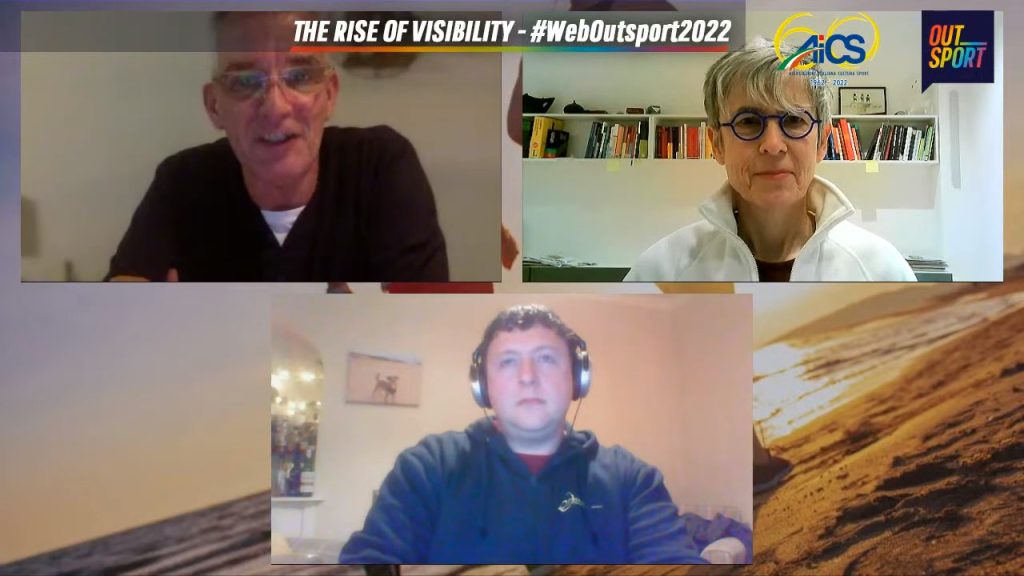
Ilse Hartmann-Tews. The intentions of the volume are first of all to explore and critically assess the challenges and experiences of LGBTQ athletes and sports inclusion policies with regard to LGBTQ people in various European countries. Another central intention of the book is to raise awareness of and be sensitive towards the different experiences and challenges of LGBTQ individuals in face of the heteronormative and often hegemonic masculine social structures of sport in Europe and elsewhere.
These reference points shape the structure of the book, and the chapters are organised into three parts. Part I situates the book as a contribution to the field of sport-related LGBTQ research, with an explicit focus on the situation in Europe. Part II focuses on country-specific issues, examining the experiences of LGBTQ people in sport and inclusion policies in seven European countries. Part III covers a variety of topics with regard to specific subgroups of LGBTQ people (gay men, lesbian women, and transgender people) and the (policy) contexts of sports in which they are involved (leisure sports and competitive sports).
The evidence of the chapters in the book provides a foundation for public sports administrations, sports organizations, and individuals involved in sports to identify ways and means to curtail discrimination and mitigate the harm experienced by members of this population. However, the research shows that future studies need to address specific issues in the field with regard to at least three areas. First, research is needed to understand differences and intersections in the forms of discrimination between the subgroups of lesbian, gay, bisexual, transgender, queer, and intersex people, taking into consideration sexual orientation and gender identity. Second, studies are required to understand the reluctance of sports officials to take meaningful anti-discrimination action against LGBTQ discrimination. Finally, research is needed to evaluate the already existing programs and educational resources on LGBTQ inclusion.
Routledge announced that the publication should be out at the end of May 2022 and it will be downloadable for free.
You have been active in the field for many years through the work of LEAP Sports Scotland and EGLSF. Did the experience that you have gained from Outsport improve your advocacy work?
Hugh Torrance. I was involved as a partner in the original Outsport project, leading the Scottish arm of the research. It has been a great opportunity to bring together the findings of the research with the experience I gained through activism in queer sports, and most recently through my role at EGLSF
As Ilse Hartmann-Tews was mentioning, there has been a real increase in attention that’s been paid to this agenda in recent years, but that’s not always effective attention. I would like to share a quote from the Council of Europe from 2019: “Sport continues to be a hostile environment for LGBTIQ persons, where little real progress has been made in comparison to other areas. Despite a definite increase in the number of states reporting measures to tackle discrimination, the invisibility of LGBTIQ persons is evident.” We have this situation where despite indicated and reported progress in anti-discrimination or in equality/diversity/inclusion policies and initiatives, LGBTIQphobia in sport is defiantly persistent and supported by a sports system that is proud of its autonomy, independence, and its specificity.
The barriers in sport are something that we continuously deal with at EGLSF. Almost every LGBTIQ person that we encounter has a story to tell about the relationship that they have with sport and the barriers that they have experienced. That can be things like tireless efforts to escape from physical education at school, discomfort in changing rooms, navigating how and when to come out to your teammates, overhearing lgbtiq-phobic language, and also far too often many real direct experiences of violence, harassment, and discrimination in sport settings. That came through quite clearly in the findings of the Outsport research too. Addressing your question about anything which has really changed for me, it’s been the extent to which some of those things have been evidenced. That has really inspired me to increase the level of advocacy that we do within our sports work.
EGLSF was first established in 1989 and it was set to act as an umbrella organisation for inclusive sports clubs and of course to manage the EuroGames. The growth of inclusive sports clubs and groups across Europe has been huge, there are now 170 clubs representing 22,000 people under the EGLSF umbrella. The success in that growth and the backbone of the clubs has been the individual community activists and the allies who have volunteered thousands upon thousands of hours to develop and lead and deliver all of those efforts at the grassroots sports level.
The question I am most frequently asked is “Why do you need these clubs?”. I think the starting point for me is that full equality in sport for LGBTIQ people needs to be understood and addressed as a rights issue and from that point of view, there is a lot of work to be done. For many people, those clubs offer a safe space, a respite from heteronormativity and cisnormativity. It’s a place where, ironically, your identity is simultaneously really important but it also doesn’t really matter. Lots of us take part in fitness or sports competition, but for many others it’s about friendship, identity, solidarity, social support, community, even finding a partner. All of that is really valid, I think, and it’s fundamentally about our right to practise sport with others like us. I should also give a shout-out to the fans groups as well because enjoying sports as a fan or as a spectator is a really important aspect of the sports system too and it shouldn’t be overlooked.
I think too often the discussions that we have here are limited to narratives of participation and competition, but actually, sport does provide an important dimension for our health, our well-being, our culture, and activism and it’s a key arena in that ongoing struggle for us around equality and human rights. Community spaces for queer people, I think, have tended historically to be built around pubs and nightclubs more than sports spaces, so another kind of key driver for change has been the demand and the need for alternative community spaces, and the LGBTIQ sports clubs create that. In fact, LGBTIQ sports spaces represent much more than sport. Many of them do some very deliberate advocacy work whilst for many, in some parts of the World simply existing can be a political act or an act of defined activism.
Thinking about the role EGLSF plays, we do undertake lots of that advocacy work within the European institutions, as Francine H. Raveney, Deputy Executive Secretary of EPAS mentioned earlier. We are a member of the EPAS Consultative Committee and it’s been really important for us to use that opportunity to speak on behalf of our community and to affect change to the extent that we can.
Sport is an arena that is also a key battleground for hearts and minds. At the moment we are seeing much of the same anti-trans and gender-critical attacks in sport as we are in other parts of society and they were condemned only very recently in a Council of Europe resolution – this is a great example of the importance of advocacy work. We don’t really have a choice but to prioritise advocacy work. It’s imperative that we protect and that we build on the progress that we have made around LGBTIQ inclusion in sport and that we fight strongly against the backsliding of LGBTQ involvement in sports. It’s time that we shift past the rainbow and move towards long-term cultural changes.
Does the rise in visibility have an impact on your work as an educator?
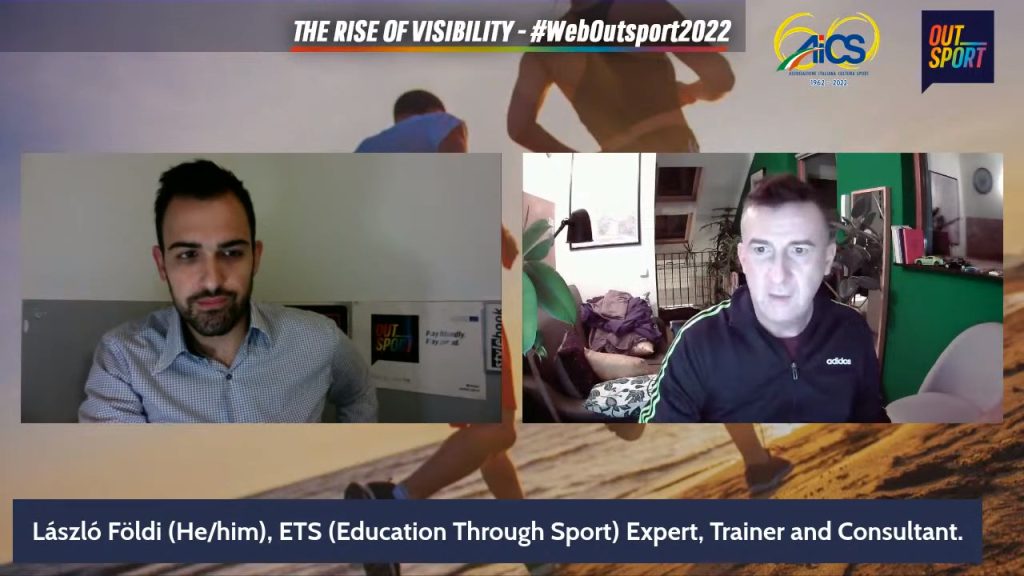
László Földi. It’s very important to remember that in modern sports there have been some major achievements in terms of human rights, but there is still a long way to go. LGBTIQ inclusion in sports is a human rights issue and should be addressed as such. Sport is a reflection of culture, it is not a separate domain that is isolated from other social processes. Since sport is a community activity, it is also a space for learning, reflecting all the problems and challenges we face in our societies, and those problems depend on the culture we find ourselves in.
Usually, people who are involved in sports argue that sport is a different world with its own rules, procedures, domains, and leaders. This doesn’t help the LGBTIQ community, as sometimes this isolation validates bad habits and traditions that have never been challenged before. Another issue we are facing is the commercialization of sport, which is obviously not helping, as it is exposing the sport activity also as a product, as a source of income, and as a profit-maker. These tendencies are definitely not supporting the wished achievements that we would like to see.
I think the Revised European Sports Charter is a very good tool to reflect on, and also a very good reference document, at least in Europe, but we are still very far from the goal. In fact, those who are leading sports should have the competencies to run an inclusive sports community, and that is not happening. This has to be taught in training courses and in universities. What we recognized in the Outsport project is that there are certain knowledge skills and attitudes that are required for those that hope to create an inclusive sports environment.
In Europe, however, it is not systematic that we come out of secondary school having a very clear understanding of gender issues or human rights issues at large. Of course, people are very quick to understand what their own rights are, but the real challenge is to make them respect other people’s rights. Of course, it is also a social and policy issue, but at the end of the day, it will be people who will have to be able to create the quality that is required for an inclusive sports environment. There are several policy attempts to create the need and the inspiration for all those who are working in sport to think of a way to create an environment that allows an LGBTIQ inclusive sport community, but this still requires a lot of work from sport organisation leaders to coaches and to the athletes themselves. As a human rights educator, I see this as a purely educational and pedagogical issue, and I think we still have a long way to go.
Roundtable – 2021 in review – From the ever-growing number of out LGBTIQ athletes to the new IOC Framework.
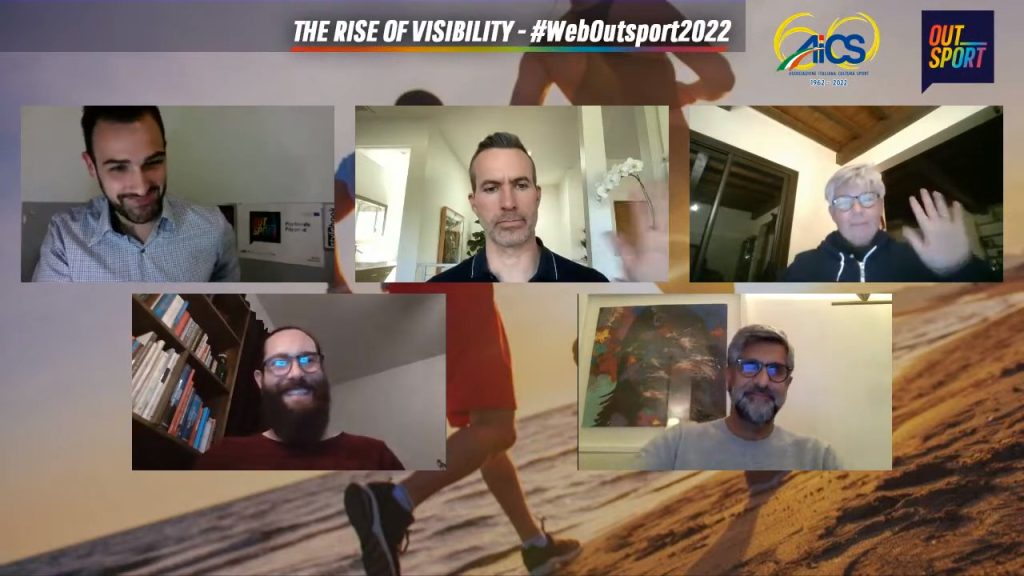
Cyd Zeigler, co-editor at Outsports.com, Sarah Townsend, co-President at EGLSF, and Piara Powar, Executive Director at Fare Network participated in this panel moderated by Rosario Coco.
Cyd Zeigler opened the session by presenting the main outcomes of a study regarding the coming out experiences of athletes from high school and college sports in North America.
Cyd Zeigler: Over the last twenty years at Outsports.com we have featured the coming out stories of athletes from across the world of sport. We have noticed a lot of them tell us that they find a lot of acceptance from teammates when they come out. Yet, as a number of people have said so far, there is this perception that sports are a homophobic institution, and that athletes hate LGBTIQ people. So we engaged with the University of Winchester and the Sports Equality Foundation to put together a set of questions, asking people in North America (USA and Canada) their actual experiences coming out to teammates. In the United States, the two areas where we have the most athletes are high school sports (ages 13 to 18) and college sports (ages 18 to 23). We had a thousand responses from athletes who would come out to their teammates – 370 from high school and 630 from college. The people who came out to their teammates told us that they had an overwhelmingly positive experience: overall, 82% had a positive experience, while only 5% said their overall experience was negative.
We also asked athletes how the reaction of their teammates was compared to their expectations. Almost 97% of the athletes said that their teammates’ reactions were the same or better than what they expected them to be, and only 3% said they were worse. Interestingly, most of the people who said it was worse were women, because the women came in with better expectations about how their teammates would respond, and some of them didn’t get the highest acceptance level that they may have expected. Men had lower expectations and more often than not their expectations were exceeded. What this shows us is that whatever we are telling these young athletes is falsely showing what their teammates’ reactions are going to be to them coming out.
We also wanted to see within the context of the school they were competing in, and what we found was that LGBTIQ athletes’ teammates had a better response to them coming out than their other schoolmates. Almost 32% said that their teammates responded better than their schoolmates, and only 10% said that their teammates responded worse than their schoolmates. Again, what that shows us is that while we focus a lot on sports and homo-bi-transphobia in sports, sports actually builds bonds between teammates in a way that may not happen in arithmetics class, art class or history class. When athletes come out, their teammates by over a 3 to 1 margin have a better reaction to them coming out than their other schoolmates.
We have identified that the real issue is language. Most of the athletes we asked heard anti-LGBTIQ language from teammates. 70% of them heard on a weekly basis at least one teammate used anti-LGBTIQ language, but after they came out, that 70% went down to 49%. This happens because after the athletes come out their teammates change language and behaviour. They understand that their language may betray how they actually feel about their LGBTIQ teammates and they change the language that they use. Our study shows that 78% of the athletes who have come out to their teammates were never targeted by anti-LGBTIQ language after they came out. Only 2% said that the language that was used was mostly always targeting them. Most athletes do hear anti-LGBTIQ language from teammates certainly before they come out, but when athletes know that there’s an LGBTIQ person on their team, they reduce their use of this problematic language, and those out athletes rarely or never have teammates direct anti-LGBTIQ language at them.
Our big conclusion is that language in sports betrays how people actually feel about LGBTIQ people and teammates, at least in North America, and given polls about same-sex marriage and homosexuality in much of Europe, I have to believe that a lot of these numbers would translate pretty accurately to sports there as well.
Maybe we should work on education and we should try to look at the evolution of younger generations, focusing on their mindset and on how they are developing a new way to think about sport. Do you think this study could confirm this perspective?
Cyd Zeigler: This study was answered by people who came out to their teams over the last 20 years and the acceptance level reported didn’t change much from 10, 15 years ago till now, although it obviously improved. I still believe that coming out is the most powerful thing we can do because as we saw people’s behaviour changes when they know they have somebody who is LGBTIQ on the team, but certainly the perspective of today’s generations, and not just today’s young generation – everyone today has shifted in every opinion poll about virtually every LGBTIQ topic.
Even though we know that athletes are hearing homophobia from coaches, teammates and fans, what we have found is that when athletes find the courage to come out in those atmospheres they find widespread acceptance, and that language does not reflect the actual acceptance that exists.
Despite the evergrowing number of out athletes and the progress that has been made in terms of female participation in sport, discrimination and sexism are still thriving. How inclusive is the sports environment for athletes who come out in 2022? And what about women?
Sarah Townsend: 49% of the athletes at the Tokyo Olympics were women. But just relying on numbers is very misleading, and I think that limiting a discussion of gender equality or inclusion to numbers gives us a false perception of reality and blocks us from addressing equality in a substantial way. The institutionalised practices in sport still don’t really allow a space to welcome women in all their diversity to the game.
Last year, EGLSF was part of a consortium that submitted a briefing note on violence and discrimination against LBTI women in sport to the parliamentary assembly of the Council of Europe, and in the data that was collected, it was very revealing that the violence and discrimination that women and LBTI women face are largely invisible, as we still don’t have a lot of data, a real picture of what is happening out there. Women who don’t conform to the community-based gender norms that are related to appearance, sexual orientation, or participation in sport are still subject to a lot of harassment and exclusion.
I think that the protest against the sexualization and the objectification of women is still something that clearly needs to be dealt with. For example, at the Tokyo Olympics, the German women’s gymnastics team competed in unitards as opposed to the bikini-cut leotards that gymnasts usually wear. On the other hand, Norway’s female beach handball team was fined at the European championship in 2021 because they didn’t want to wear skimpy bikinis. This points out the disparity between women’s uniforms and men’s uniforms.
If we look at participation in women’s sport, it is clear how we still don’t have the equality and the visibility that we should be getting. The age-old argument is that women’s sports won’t draw the audiences, but if you don’t give the airtime to women’s sports then you won’t be able to break that cycle. Some progress is being made, but we still aren’t on a par with men’s sport and we are far from having the visibility that we should have. Cyd Zeigler talked about language, and if we consider the words that are used on television or in general media we see the absence of women, we see how the world of sport is dominated by men. For example, very often we hear a comment that Justin Fashanu was the only professional gay footballer who came out while he was still playing, but that simple statement is negating the whole women’s game.
LBTI women are underrepresented, and when you add the layer of race the issue of representation becomes even bigger, as the internalised and institutionalised prejudice becomes even more apparent. Last year, FINA banned swimming caps designed for natural Black hair at the upcoming Tokyo Olympics because they didn’t fit the “natural form” of the head, suggesting that women of colour don’t have a natural form of the head. Comments like this just show how ingrained prejudice is. This brings us back to this idea of sport having been developed around a very radicalised masculine ideal, and anything that is not male becomes problematic.
The inclusion has been presented, but with the barriers that are formed by the cultural ideologies about women’s bodies, the ideas of public exhibition about women’s bodies, and ill-formed ideas about physical capabilities and risks that we would face. An institution defining who a woman is and who belongs in a women’s category and what a woman’s body should be like started with the beginning of sport. As I said, some progress has been made but we are still in that realm of defining this categorization, we are still working around this policing about what is possible and what is not. The definitions of femininity in sport are restricted to an idea that is imposed by the institutions of the global North. Women who don’t fit the standards of western female physicality are singled out. We see clearly with all the sex and testosterone testing that has been going on that it’s women of the global South that are primarily forced to prove their femininity. This intertwining of racism, misogyny, and transphobia is still very present.
Although we have made strides as a society towards inclusion and anti-discrimination in sport, I think our sporting institutions and policies haven’t caught up with that, and it still causes very direct discrimination against women, if it’s not causing a lot of women to not even be present in the arena at all. We have made a step forward with the latest IOC framework – it is not going to solve everything but it is giving us a different basis to start with. The fact that testosterone is not the sole way that competition in women’s sport is going to be regulated is a step forward – there’s a pathway to equality that is being approached by the guidelines. The fact that the guiding principles are moving towards a presumption of no advantage and that the guiding principles are now regarding trans inclusion and bringing in non-discrimination as a core value is a great step forward. Yet, I still think that federations are going to have a lot of work to do to actually bring that into practice, and I think unfortunately women are still going to be struggling to have their rightful presence in the arena of sport.
The upcoming World Cup in Qatar is a great opportunity for visibility in a country where LGBTIQ people are invisible. How to give them a voice?
Piara Powar: At Fare Network we work in football, and for us, the experience has been that there are a lot of women who are out and proud and it’s very much a part of women’s football. But in men’s football, although there have been people who have come out, only a handful have come out whilst they’re still playing. That sense of acceptance and security that Cyd Zeigler talked about within professional sports in the USA, and particularly within the college sports sector, doesn’t really exist in football. Many coaches, youth trainers, and many people in administration use forms of language that exclude those individuals who might even be considering coming out and being clear about their identity. Although Cyd was being very optimistic, I would say that the global situation in football is quite different from many American sports.
I think it’s important that we look at the situation in terms of LGBTIQ rights globally, as the picture is not even. Generally speaking, without turning this into a sort of a North-South or East-West divide discussion, in Western Europe and North America we generally have quite advanced debates around LGBTIQ rights and there are legislations that don’t exist in many other parts of the World. We have seen Russia, China, and Qatar host huge sporting events even though the governments of these places violate human rights and also have laws against LGBTIQ people. While getting ready for the World Cup in Qatar, the football world has to make the best of it and push for change both within the country but also outside, in terms of our interactions with Qatar.
Our primary concern, as the Fare Network, has been to pull together an alliance of sixteen organisations from the Middle East, Europe, and North America who have been working in this area for some time, and we have been talking to FIFA and to the government of Qatar to protect LGBTQ athletes, workers, and spectators. The Qatari government has a number of reasons as to why they say that they can’t act in this area: they argue that if they were to open up, many of their enemies in the region would see it as an offence. Most of them are Islamic states and would find that an alien concept and would then be reaching out to the conservatives in Qatar, asking them to put a stop to that.
It’s a complex picture, but we are very clear that the rights of LGBTIQ people must be respected. These mega sporting events that are being hosted in non-Western countries are very important because they give us an avenue in which we can begin to open up a discussion with those governments, and we can begin to have a public discourse about the situation. We also want to leave a legacy that is positive for local communities that would be affected by the legislation they are living under. We are planning to go public with our set of demands via a public communication campaign. In Qatar, it’s not just the LGBTIQ community that is the subject of human rights concerns. There have been a lot of concerns about migrant labour, for example, and that has been the human rights issue that has been at the forefront of debates around Qatar.
The protection of the LGBTIQ community has been very much a secondary topic, and it’s our objective to try and move this up the agenda. In general terms, I think we need to let people know that we are trying to get guarantees of safety. We are trying our best to get some minimum standards in place around training, and around the guarantee that the people are not excluded or arrested for their identities. Last but not least, all of us who are from minority communities and are interested in sport need to be mobilising and looking to make sure that sponsored mega-events are being hosted in countries where there is respect for minority communities in place. It becomes very difficult, once competitions are awarded, to try and generate a debate in the public sphere to try and win gains that are very difficult to do, and we also know that there is an LGBTIQ community in Qatar. The question for us is how can we help them, how can we leave a legacy for their lives going forward and not just look at the rights of visitors or short-term workers.
One of the interesting things about this tournament is that FIFA’s regulations prohibit discrimination on paper. They have also been taking action in Latin America for example, where homophobia inside stadiums is rife. I think the issue that they will have while hosting the World Cup in Qatar, is the fact that this event is a partnership between the Qatari government and FIFA. Qatar lacks acknowledgment of the issue and lacks the willingness to move forward.
I think sometimes when we say that an event is open to all, that everybody is welcome, that is not good enough. Given the concerns that exist, we really do need a focus on the community and for FIFA and others to be saying the LGBTIQ community specifically is welcome along with everybody else. Nevertheless, this is not that sort of situation where FIFA can force the Qatari government to open up the tournament in the way that we want them to do. It is surely a big frustration for them and a bigger one for us, given the fact that we have been working on this for more than two years now.
Roundtable – Transgender and intersex inclusion in sport after the new IOC framework on gender identity and sex variations: current practices and perspectives.
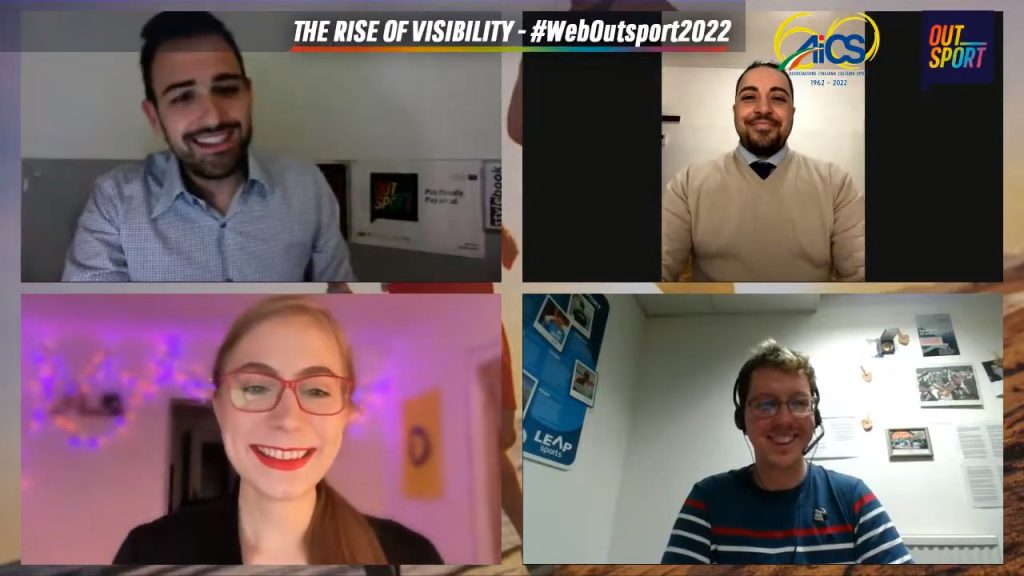
The last session of this webinar, moderated by Rosario Coco, was attended by Martin Muñoz – Project Manager at Seitenwechsel Sports Club, Mat Wilkie, Trans Inclusion Officer at LEAP Sports Scotland, Irene Kuzemko, Community and Capacity Building Officer at OII Europe and Gabriel Corbelli – AICS LGBTIQ Sector, who explained more in detail the new IOC guidelines.
Gabriel Corbelli: On behalf of the AICS LGBTIQ Sector I would like to tell you about the new IOC guidelines, issued in November 2021, regarding competitive sports competitions for transgender and intersex people. The new indications are much more inclusive than the previous ones released in 2015, which is a sign of increased sensitivity towards these issues.
The IOC seeks to promote a welcoming and safe environment for all, with the aim of implementing gender equality and inclusion, through the training of managers and technicians and the design of information campaigns aimed to prevent harassment and abuses in sport, taking into account personal needs and vulnerabilities. When it comes to eligibility criteria, the IOC entrusts this task to the individual federations and sports organisations, underlining the importance of respecting the principles of inclusiveness: through a design, an implementation method, and an evaluation model based on the physical, psychological and mental well-being of the athletes concerned, directly or indirectly predicting and identifying negative impacts.
One very relevant aspect is that athletes should be allowed to compete in the category that best aligns with their self-determined gender identity: this is a big win, considering that transgender people were only invited to participate in the Olympics in 2004, where sex reassignment surgery, sex registry rectification, and hormone therapy for at least 2 years were required. Instead, the 2015 document eliminated these requests, apart from the question of hormone therapy (12 months) for MtF athletes, but the obligation to carry out specific medical tests based on testosterone levels was included. Obviously, the issues that are most recurrently raised relate to MtF athletes on the basis of the prejudice that being born with a male body they are thought to have an automatic advantage over other women.
Another important element is transparency with regard to decision-making processes, a fundamental principle that is at risk of conflict with the right to privacy of transgender and intersex people, therefore the necessary farsightedness is required to prevent the public disclosure of information on personal health. This process will have to be characterised by periodic reviews linked to both scientific, medical, and human development.
We, transgender people, face the difficulty arising from the choice of changing rooms within gyms, given the current sex separation system. Over the years, there have been several proposals to overcome this issue. One of those that at a first glance seemed more reasonable to me was to add a third dressing room without specifications, open to everyone. I soon had to face reality: there is closed-mindedness, especially in families, and there is a lack of facilities that allow us another space to create that third dressing room.
As the proverb says, necessity is the mother of invention. For once, I used the strict Covid containment rules in a positive sense, as these rules asked us to ensure a clear division between the teams participating in sporting events. With this “bubble” system, each team would have its own dressing room, therefore a choice not based on gender. In karate, a sport that I have been practising for over 30 years, I trained in gyms that still follow the path of the gender-neutral locker room. This experience taught me respect for others and
kept me far from “free zones” where sexism and homotransphobia proliferate, and it is, therefore, a reality that I propose in my small way in the structures where I teach.
I think that the changes must be made one step at a time by looking for every kind of trick that is useful for the goal, which for me is to achieve psycho-physical well-being through sport and social life, as well as becoming an ethical and inclusive model that can improve respect in our societies.
Trans and Intersex visibility at the Olympics and Paralympics: how can grassroots sport use it and turn it into a tool for inclusion?
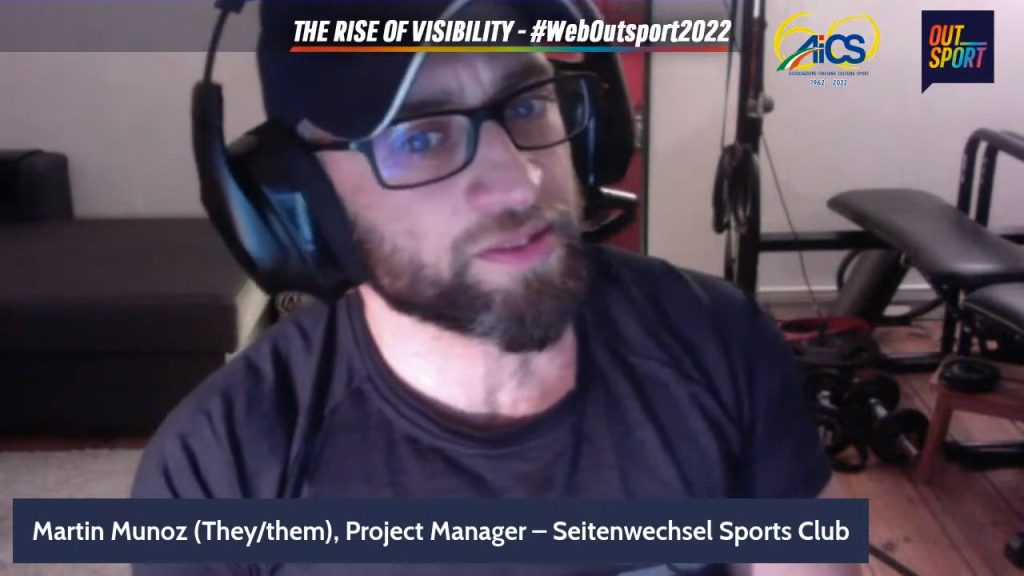
Martin Muñoz: When I saw that the new IOC guidelines talk about needs, vulnerability, and respect for trans and intersex people I felt like we can be a part of the sports community in the future, with less prejudice and unfairness. Now that we have an official, authoritative document stating that we are humans and that we have rights, the role models for young people could help the visibility in the Olympic and Paralympic games, sports clubs could be more aware of the topic and federations could take more responsibility. Like Sarah Townsend said before, we have a lot of work to do, and maybe society can have a positive image of trans and intersex people when they are involved in sport, and we can normalize our identities. I think it is important to stress that we are valid, that we have the right to participate in sport, and that we shouldn’t be segregated – as Gabriel Corbelli mentioned earlier, there is widespread resistance against transgender people being part of the changing rooms.
The new IOC framework talks about the needs of trans and intersex people and actually, this is a huge opportunity for us to advance the work we are doing at Seitenwechsel. Over the last two years, we have developed a project where we implemented a gender diversity charter for sport, considering all the experience we had and the mistakes made during the last 15 years to be as open as possible for trans, intersex, and non-binary people. We took a collection of classic and critical issues that are important in the implementation of sport clubs for all genders and focused on transgender and non-binary people.
Now that there is more visibility of trans people and trans issues in sport, I think that we can approach sport federations with our framework and the federations can apply pressure to clubs that this is in fact a topic that needs to be addressed. This charter has nine aspects including recognition, language, visibility, documentation, spaces, protection, and innovation. There are educational models where we explain and give examples of what can be done so that clubs and organizations can take the first step in meeting the needs of trans, intersex, and non-binary people so there are fewer barriers to practice sport in a welcoming environment.
Now that the IOC issued new guidelines, every single federation will have to review and change its charters. What challenges are ahead of us?
Mat Wilkie: Talking from a Scotland-specific context, it is important to place these IOC guidelines within the transphobic culture in Scotland. At the moment within Scotland, we are seeing a really unprecedented organisation of anti-trans groups who are managing to strategically use mainstream media and backdoor legal challenges in order to withdraw and hold the progress of trans rights.
Another situation we have in the UK and Scotland is a domestic sporting policy published a couple of months before the new IOC guidelines, which unfortunately isn’t as progressive. I’ll have a quote from it: “Competitive fairness cannot be reconciled with self-identification into the female category of gender affected sports”. On the contrary, the IOC policy has the opportunity for us to really take steps forward. Now, all the different federations and sporting bodies have the potential to be involved in developing their policies.
A challenge is how we support them and encourage them to do that within the progressive framework of the IOC and not be influenced or infiltrated, as anti-trans groups or organisations actually have a lot of ground currently in Scotland. We have a real worry there and lots of work to do to make sure that the policies being developed are ones that are focused on these principles of inclusion, and there is the involvement of an engagement of non-binary people within these policies and within the traditional male and female sporting groups. There isn’t a long-standing framework for that either, so it’s quite a new ground that will take a lot of consideration.
A second challenge I’d like to mention is how we take this sort of élite guidance and how that infiltrates grassroots sports. Of course, when they will be developing trans participation policies it’s going to take quite a lot of work for different governing bodies or federations to have nuance between élite and grassroots, non-competitive sports. At LEAP Sports Scotland, we work quite a lot with trans communities, supporting them to access sport for the first time or to access it again after instances of transphobia or prejudice.
With the different policies being developed, there’s a lack of confidence as to how people who are entering sports now will be able to participate into the future, but whether they enter a sports situation now they’ll be able to continue to engage in the same way in the future when new policies come in. A challenge is to support people within trans communities to access sports and have the confidence that however or whichever sport they access there will be space there for them to engage and play with their human rights respected.
Did you notice any significant changes that improve the situation of intersex athletes in recent years, and if so, where?
Irene Kuzemko: Before describing the positive changes, I want to give a little bit of background. Sarah Townsend, Gabriel Corbelli, and other speakers already touched on this topic, but I’ll continue: there is a long history of intersex athletes having their human rights violated, simply for being born with variations of sex characteristics. The practice of sex testing took many forms throughout the years. In the 1960s, World Athletics began doing physical examinations, and the International Olympic Committee began conducting chromosomal tests which stopped in 1992. In 2009, World Athletics began a practice of hormone testing, which continues to this day.
Behind the practice of sex testing, you always find racism, nationalism, and sexism, as the majority of athletes targeted are women of color from Africa or Asia. Furthermore, sex testing is not a mandatory procedure for all athletes – only female athletes who don’t fit the societal gender stereotypes of femininity are selectively subjected to those tests. In 2018, World Athletics introduced eligibility regulations for female qualification which mandate that all female athletes whose testosterone levels exceed a certain amount will be forced to take drugs that suppress their natural testosterone levels in order to be eligible to participate in sports. This is done despite the UN resolution on the elimination of discrimination against women and girls in sport, specifically noting the World Athletic regulation may not be compatible with international human rights norms and standards. Despite this, World Athletics revised its guidelines in 2019 to specifically mandate testing and coerced treatment based on testosterone levels linked to certain sex variations. All this attention is given specifically to testosterone levels, despite sports experts claiming testosterone is only one of the many factors impacting athletes’ performances and the naturally occurring differences in humans, such as oxygen uptake, capillary density, leg length, and many others.
Regardless of whether testosterone should be considered a key performance factor or not, the World Athletics regulations in the first place might lead to further discrimination of athletes with variations of sex characteristics in all areas of sport. According to the 2016 report by the UN Special Rapporteur on the right to physical and mental health, these policies have led to women athletes being discriminated against and forced or coerced into treatment for hyperandrogenism and a number of athletes have undergone gonadectomy and partial cliterectomy in the absence of symptoms or health issues warranting these procedures. Furthermore, the implementation practices of these regulations can include discriminatory practices and the violation of the right to privacy as well as the possible physical and psychological side effects of coerced medication. Lastly, media attention and the unconsent that public reveal of private medical data of intersex athletes adds even more stress and trauma to the entire situation. The same thing would happen if the hypothetical third category would be introduced in sports because it would automatically out the person and attract media attention to their private details.
Many intersex people OII Europe is in contact with indicated that sex verification testing and practices, and the potential to be exposed to invasive medical examinations and having to possibly relive their past trauma and medical violence or non-vital medical interventions survived in infancy or childhood by so many intersex people. It already has a dramatic impact on their desire to participate in sports altogether. Obviously, the case of famous South African 800 meters world and Olympic champion Caster Semenya has been one of the most widely reported cases of discrimination against female athletes due to high testosterone levels. Semenya herself reports that the scrutiny of sports situations and all the media attention has destroyed her mentally and physically. In 2021, Semenya took her case to the European Court of Human Rights. Her lawsuit challenges the restrictions on testosterone levels for female athletes that prevent some women from participating in international sports competitions.
Still, in 2021, the International Olympic Committee released the framework on fairness, inclusion, and non-discrimination on the basis of gender identity and sex variations. This framework recognises the need to ensure that everyone, regardless of their gender identity or sex characteristics can practice sport in a safe, harassment-free environment that recognizes and respects their needs and identities. Despite not being legally binding, this framework is a step in the right direction. The release of this framework gives us hope that even though there is still a long road ahead of us in the fight for the rights of intersex athletes to compete, there is hope that intersex associations around the World will take on the spirit and would develop a further binding framework that adheres to human rights and guarantees that no athletes would be subjected to discriminatory testing and forced treatment. I want to close by sharing a quote from Caster Semenya: “I hope the European Court of Human Rights will put an end to the long-lasting human rights violations by World Athletics against women athletes. All we ask is to be allowed to run free for once and for all, as the strong and fearless women we are and always have been”.
Do you think federations will try to find different rules for transgender and intersex inclusion in different sports, and do you see difficult challenges ahead?
Martin Muñoz: I think the main challenge will be related to the fact that we will have many different rules for each sport, so we will have to fight in order to monitor and harmonise them. It won’t be easy, but we are moving in the right direction.
Mat Wilkie: Recently, I was providing trans inclusion guidance for a sailing club and they were talking about how a competitive advantage is framed in the sailing world, and that it is significantly different from how competitive advantage may be framed in any different sport. So we began thinking of different ways that we can foster competition and the different ways that competition can be framed within sailing, which are absolutely varied. We started thinking about the fact that there were loads of different things about precision or things that were not related to how fast you did something. I think, although it would be complex, we can encourage different organisations in different sports to start thinking along these lines. Once they do, there is a great possibility for them to engage with that and develop their framework around it.
Irene Kuzemko: I just hope that intersex people or any people with variations of sex characteristics would not have to go to literally change their bodies in order to belong to one gender or another. When I think about the divide of sports in different genders, I always think about chess, a sport where your physical abilities have nothing to do with your performance, yet this sport is usually gendered and separated. So maybe this separation is not so much about physical characteristics and physical performance?
Conclusions by Fabrizio Petri – Special Envoy for the Human Rights of LGBTIQ+ Persons – Ministry of Foreign Affairs and International Cooperation – Italy
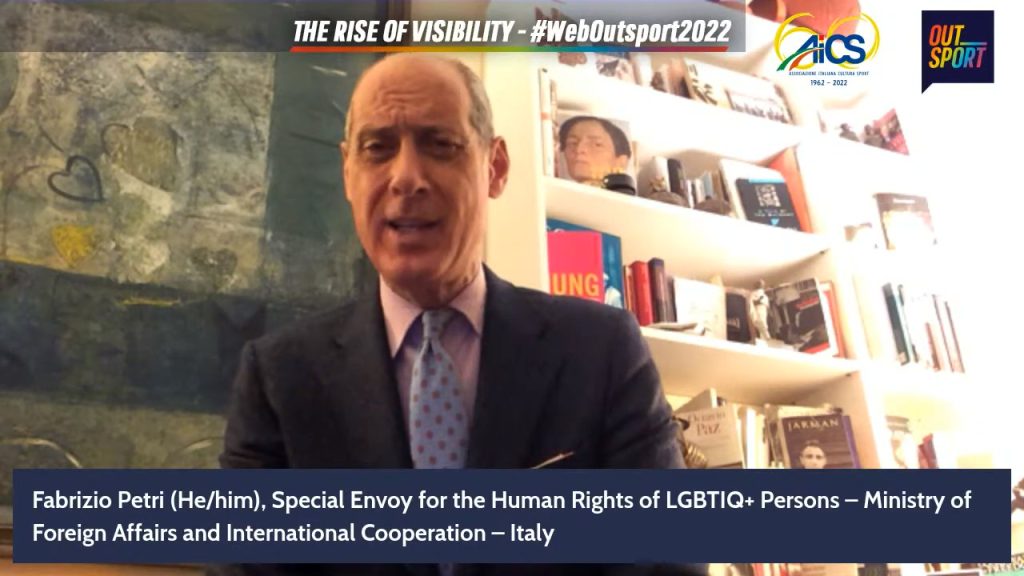
Fabrizio Petri: I would like to thank the Outsport project for bringing together so many important contributions. I am impressed by the amount of useful information that was shared today during this webinar. I have just been appointed a Special Envoy for the Human Rights of LGBTIQ+ Persons by the Ministry of Foreign Affairs and International Cooperation of Italy, and I can see improvement and a growing consciousness, despite the challenges. I am also president of the Italian Committee for Human Rights, and the government wants me to keep these two hats just to underline how important the dimension of human rights is. Of course, we are far from the ideal conditions, but I think that the work and the research you are all doing are a solid basis for future advancement in Italy and beyond. When institutions, international organisations, and civil society are in sync, great things can be achieved. I am really happy because I learned a lot today, and I hope we will work together in the future.